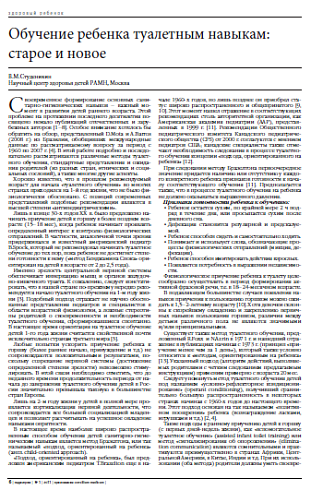Материалы доступны только для специалистов сферы здравоохранения.
Чтобы посмотреть материал полностью
Авторизуйтесь
или зарегистрируйтесь.
Обучение ребенка туалетным навыкам: старое и новое
Обучение ребенка туалетным навыкам: старое и новое
Материалы доступны только для специалистов сферы здравоохранения.
Чтобы посмотреть материал полностью
Авторизуйтесь
или зарегистрируйтесь.
Полный текст
Список литературы
1. Fleisher DR. Understanding toilet training. Pediatrics 2004; 113: 1809–10.
2. Klassen TP, Kiddoo D, Lang ME, Friesen C et al. The effectiveness of different methods of toilet training for bowel and bladder control. Evid Rep Technol Assess (Full Rep) 2006; p. 1–57.
3. Студеникин В.М. Психомоторное, эмоциональное и социальное развитие детей раннего возраста: роль правильного формирования санитарно-гигиенических навыков. Cons. Med. Педиатрия. 2008; 2: 78–80.
4. Mota DM, Barros AJ.D. Toilet training: methods, parental expectations and associated dysfunctions. J Pediat (Rio J) 2008; 84: 9–17.
5. Студеникин В.М., Студеникина Н.И. Уход за кожей детей первых лет жизни: нейропедиатрические аспекты. Лечащий врач. 2008; 3: 66–70.
6. Blum NJ, Taubman B, Nemeth N. Relationship between age at initiation of toilet training and duration of training: a prospective study. Pediatrics 2003; 111: 810–4.
7. Blum NJ, Taubman B, Nemeth N. Why is toilet training occurring at older ages? A study of factors associated with later training. J Pediatr 2004; 145: 107–11.
8. Horn IB, Brenner R, Rao M, Cheng TL. Beliefs about the appropriate age for initiating toilet training: are there racial and socioeconomic differences? J Pediatr 2006; 149: 165–8.
9. Brazelton TB. A child-oriented approach to toilet training. Pediatrics 1962; 29: 121–8.
10. Brazelton TB, Christophersen AR, Frauman AC, Gorski PA et al. Instructions, timeliness, and medical influences affecting toilet training. Pediatrics 1999; 103: 1353–8.
11. Stadtler AC, Gorski PA, Brazelton TB. Toilet training methods, clinical interventions, and recommendations. American Academy of Pediatrics. Pediatrics 1999; 103: 1353–8.
12. Community Paediatrics Committee CPS. Toilet learning: anticipatory guidance with a child-oriented approach. J Paediatr Child Health 2000; 5: 333–5.
13. Foxx RM, Azrin NH. Dry pants: a rapid method of toilet training children. Behav Res Ther 1973; 11: 435–42.
14. Shaum TR, McAuliffe TL, Simms MD, Walter JA et al. Factors associated with toilet training in the 1990s. Ambul Pediatr 2001; 1: 79–86.
15. Russell K. Among healthy children, what toilet-training strategy is most effective and prevents fewer adverse events (stool withholding and dysfunctional voiding)? Part A: Evidence-based answer and summary. J Paediatr Child Health 2008; 13: 201–2.
16. Lang ME. Among healthy children, what toilet-training strategy is most effective and prevents fewer adverse events (stool withholding and dysfunctional voiding)? Part B: Clinical commentary. J Paediatr Child Health 2008; 13: 203–4.
17. Barone JG, Jasutkar N, Schneider D. Later toilet training is associated with urge incontinence in children. J Pediatr Urol 2009 [Epub ahead of print].
18. Tali S, Efrat SU, Boucke L, Rugolotto S. Infant toilet training. J Pediatr (Rio J) 2009; 85: 87–8.
19. Kiddoo D, Klassen TP, Lang ME, Friesen C et al. The effectiveness of different methods of toilet training for bowel and bladder control. Rockville: Agency for Healthcare Research and Quality, 2006.
2. Klassen TP, Kiddoo D, Lang ME, Friesen C et al. The effectiveness of different methods of toilet training for bowel and bladder control. Evid Rep Technol Assess (Full Rep) 2006; p. 1–57.
3. Студеникин В.М. Психомоторное, эмоциональное и социальное развитие детей раннего возраста: роль правильного формирования санитарно-гигиенических навыков. Cons. Med. Педиатрия. 2008; 2: 78–80.
4. Mota DM, Barros AJ.D. Toilet training: methods, parental expectations and associated dysfunctions. J Pediat (Rio J) 2008; 84: 9–17.
5. Студеникин В.М., Студеникина Н.И. Уход за кожей детей первых лет жизни: нейропедиатрические аспекты. Лечащий врач. 2008; 3: 66–70.
6. Blum NJ, Taubman B, Nemeth N. Relationship between age at initiation of toilet training and duration of training: a prospective study. Pediatrics 2003; 111: 810–4.
7. Blum NJ, Taubman B, Nemeth N. Why is toilet training occurring at older ages? A study of factors associated with later training. J Pediatr 2004; 145: 107–11.
8. Horn IB, Brenner R, Rao M, Cheng TL. Beliefs about the appropriate age for initiating toilet training: are there racial and socioeconomic differences? J Pediatr 2006; 149: 165–8.
9. Brazelton TB. A child-oriented approach to toilet training. Pediatrics 1962; 29: 121–8.
10. Brazelton TB, Christophersen AR, Frauman AC, Gorski PA et al. Instructions, timeliness, and medical influences affecting toilet training. Pediatrics 1999; 103: 1353–8.
11. Stadtler AC, Gorski PA, Brazelton TB. Toilet training methods, clinical interventions, and recommendations. American Academy of Pediatrics. Pediatrics 1999; 103: 1353–8.
12. Community Paediatrics Committee CPS. Toilet learning: anticipatory guidance with a child-oriented approach. J Paediatr Child Health 2000; 5: 333–5.
13. Foxx RM, Azrin NH. Dry pants: a rapid method of toilet training children. Behav Res Ther 1973; 11: 435–42.
14. Shaum TR, McAuliffe TL, Simms MD, Walter JA et al. Factors associated with toilet training in the 1990s. Ambul Pediatr 2001; 1: 79–86.
15. Russell K. Among healthy children, what toilet-training strategy is most effective and prevents fewer adverse events (stool withholding and dysfunctional voiding)? Part A: Evidence-based answer and summary. J Paediatr Child Health 2008; 13: 201–2.
16. Lang ME. Among healthy children, what toilet-training strategy is most effective and prevents fewer adverse events (stool withholding and dysfunctional voiding)? Part B: Clinical commentary. J Paediatr Child Health 2008; 13: 203–4.
17. Barone JG, Jasutkar N, Schneider D. Later toilet training is associated with urge incontinence in children. J Pediatr Urol 2009 [Epub ahead of print].
18. Tali S, Efrat SU, Boucke L, Rugolotto S. Infant toilet training. J Pediatr (Rio J) 2009; 85: 87–8.
19. Kiddoo D, Klassen TP, Lang ME, Friesen C et al. The effectiveness of different methods of toilet training for bowel and bladder control. Rockville: Agency for Healthcare Research and Quality, 2006.
Авторы
В.М.Студеникин
Научный центр здоровья детей РАМН, Москва
Научный центр здоровья детей РАМН, Москва
Цель портала OmniDoctor – предоставление профессиональной информации врачам, провизорам и фармацевтам.

